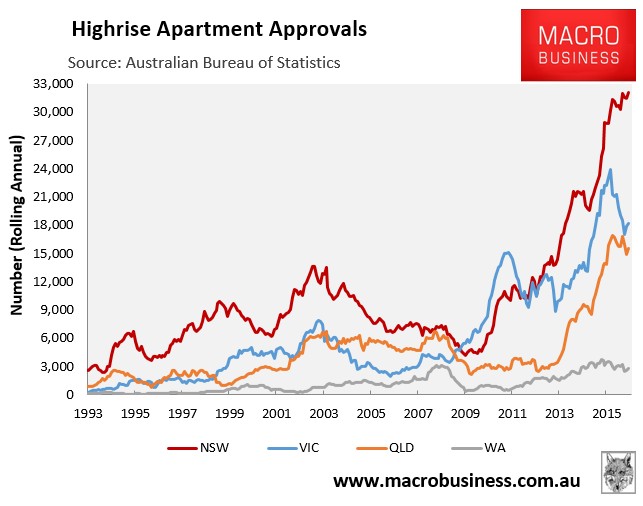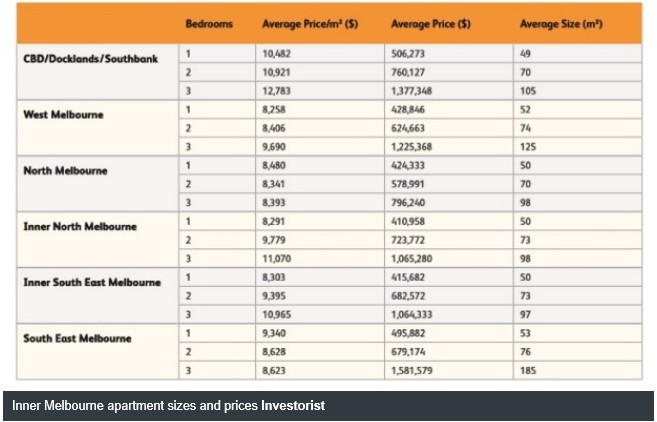As Australia’s East Coast capitals feverishly build high-rise apartments:

Questions are increasingly being raised about whether the proliferation of mostly tiny ‘shoe box’ apartments is actually benefiting existing residents.
Back in May, Four Corner’s aired its Home Truth’s special report. This featured Prosper Australia president, Catherine Cashmore, taking reporter Ben Knight for a tour through largely vacant apartment blocks in Melbourne’s CBD where, at 8pm on a Tuesday night, the lights are off and nobody is home:
Former Victorian Premier Jeff Kennett also made an appearance in the report, slamming the high-rise dog boxes proliferating through Melbourne:
“We are still building units that, to be quite honest, you wouldn’t put your dog in. I mean, some of these one bedroom vertical fridges are appalling. And I couldn’t imagine anything worse”…
“I think we are in for a crunch, there’s no doubt about it”…
Earlier this week, Sydney-based architect Kerry Clare warned that Australia is building too many poor-quality high-rise apartment towers that are alienating to live in and have low environmental performance. From The Age:
“High-rise living has a number of drawbacks including social isolation and diminished public realm amenity”…
“Current high-rise building practices in Australia make for poor environmental performance and reduced liveability”…
“Why are we turning to this solution when there is so much evidence that this is not needed or desirable?”…
“High-rises diminish people’s participation in public spaces,” she said, citing the work of another architect, Taz Looman , who has argued towers “create silos – physical, social and psychological”…
Professor Clare said high-rise towers were largely “built during economic bubbles”, and many were empty, investor-owned properties.
And on Wednesday, Clay Lucas at The Age reported on the poor quality of apartments being built across Melbourne:
…lift breakdowns were all too frequent, leaving queues of up to 40 people waiting 10 minutes or more to get downstairs.
Another, Gary Whitham, had told me earlier that the design of his apartment meant an inward opening door from the balcony created noisy wind gusts and that he left the kitchen extractor fan on all night to counter the smell of smoking neighbours.
Thanks to the work of former planning ministers Justin Madden and Guy, Melbourne’s CBD is now littered with such apartments: built without enough thought on what they would be like to live in.
All were made possible by the absence of adequate rules on apartment design…
When the notion of minimum floor sizes was raised in 2014 by the Victorian state architect, the development sector began campaigning to stamp out the idea. Minimum sizes would, the Property Council warned, “push home ownership out of reach”, with every five-square-metre increase adding $45,000 to the sale price.
Back in June, The AFR produced the below table showing the average price and size of apartments being built across various parts Melbourne:

As you can see, apartments in the CBD are being priced at more than $10,000 per square metre, with surrounding areas only slightly below this level.
The average price of a tiny one-bedroom apartment ranges from an astonishing $410,000 to $506,000, which rises to more than $580,000 for a two-bedroom apartment and $800,000 or more for a three-bedroom apartment.
Hence, Melbourne’s high-rise apartment boom has failed to deliver affordable housing options for our most important demographic: young families.
The sad truth is that the economy has become so fundamentally dependent on never-ending population growth (immigration) to pump demand and fuel the economy (e.g. via apartment construction) that it has forgotten about improving the living standards of the existing population.
Instead of creating a sustainable economy that works for Australian families, our major cities are building a whole bunch of expensive shoe boxes in the sky that are marketed for quick profit to investors (both domestic and foreign) and entirely inappropriate for resident families.
Meanwhile, those families seeking established homes are having to compete for entry level stock against a never-ending army of negatively geared investors, thus either forcing them to take on jumbo-sized mortgages or becoming long-term renters.
Alternatively, families seeking a new detached home on the fringes or our cities are having to pay exorbitant sums for a postage stamp-sized lot, courtesy of the artificial restrictions on land supply and the hyper-inflation of lot values experienced over the past 15 years.
In short, Australia’s housing system is failing.

